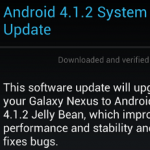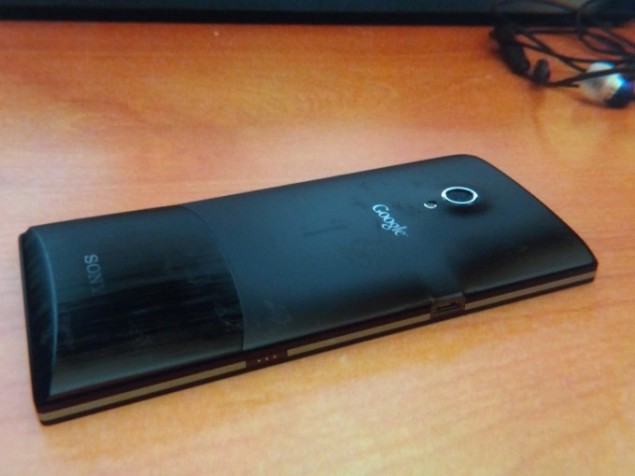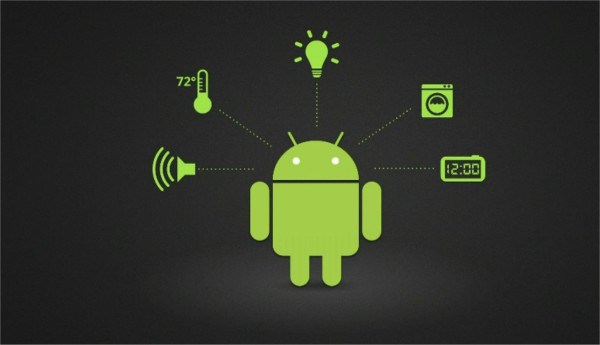Android Phone Fans |
- Official: LG Optimus G Coming To Sprint November 11th For $200 – Pre-Orders Begin Nov. 1st
- Galaxy Nexus, Nexus S, and Motorola Xoom WiFi Now Receiving Android 4.1.2 Over-The-Air
- Android 4.2 to feature quick settings accessible by dual notification panes? [VIDEO]
- Nexus 7 sales looking strong, but incoming iPad Mini threatens to steal Google’s thunder
- Google could be tackling malware problem with baked-in Google Play scanner (plus other imminent Play Store changes)
- Official: LG Optimus G available from AT&T November 2, pre-orders start tomorrow
- MetroPCS shareholders look to block Deutsche Telekom acquisition due to undervaluation
- Has Sony’s Nexus phone been revealed? [Fact or Fiction]
- Will Amazon turn TI’s flailing mobile business into tablet gold with possible acquisition?
- DIY smartphone thermostat has us wondering what happened to Android@Home
- Japan’s SoftBank purchases 70 percent stake of Sprint
| Official: LG Optimus G Coming To Sprint November 11th For $200 – Pre-Orders Begin Nov. 1st Posted: 15 Oct 2012 06:33 PM PDT It’s one of the most impressive devices I’ve ever had the pleasure of placing inside my sweaty palms and only a few hours after the AT&T version was officially dated, now Sprint customers can get in on the excitement as well. Sprint has officially announced the LG Optimus G for a November 11th launch with pre-orders beginning on November 1st for early birds. At only $200 with a 2-year agreement, the LG Optimus G packs a lot of bang for the buck. You’re getting a device with excellent build quality, a 4.7-inch True HD IPS 720p display, Qualcomm quad-core S4 processor, 13MP camera, 2GB of RAM, 32GB of internal storage, NFC and running on Android 4.0 Ice Cream Sandwich. The crème de la crème. Yes, this features LG’s all new skin but I must say, it’s definitely my favorite manufacturer UI so far (yes, I just totally went there). We’ve been putting the device through its paces since last week, so expect a full review in the coming days. In the meantime, you can drool over the new features LG’s bringing to the table in their official product movie (trust us, it’s pretty amazing). Also, don’t forget to check out our comparison post between the Sprint and AT&T versions as well as our quick hands-on with the Sprint G at MobileCON last week. Stay tuned for more, folks. |
| Galaxy Nexus, Nexus S, and Motorola Xoom WiFi Now Receiving Android 4.1.2 Over-The-Air Posted: 15 Oct 2012 05:39 PM PDT It was last Wednesday we got word that Google had made available the Android 4.1.2 factory images for the both the Galaxy Nexus and Nexus 7. Unfortunately for those that that don’t like messing around with their device’s software, this was little more than comfort that an update was scheduled to be coming at sometime down the pipeline. Today, Galaxy Nexus (yakju), Nexus S and Motorola Xoom (WiFi) owners users were greeted by an over-the-air update, bringing their firmwares up to the latest version of Android 4.1.2 Jelly Bean. The 15.1MB update brings with it a few added enhancements like landscape mode (Nexus 7 only), and single digit expandable notifications (complete with haptic feedback). Keep in mind the update for the Galaxy Nexus is (surprisingly) only for the international model and not the version sold direct from the Play Store. No worries though. We’re sure Google will be pushing out it out shortly for takju models as well, so don’t fret. For those that know what they’re doing, and feel like downloading the update to apply manually, hit up this thread on XDA. No telling when Sprint or Verizon variants will be updated (needs to go through a review process) but here’s to hoping it wont be too long. Thanks, ihparker, DP and everyone who sent this in! |
| Android 4.2 to feature quick settings accessible by dual notification panes? [VIDEO] Posted: 15 Oct 2012 02:52 PM PDT Android 4.2 is said to be on its way with the arrival of the LG Nexus, and with it should bring some mildly exciting changes. It won’t be as big as the “K” (Key Lime Pie, maybe) update that will come at some point down the line, but things are already shaping up quite nicely. So what’s new today? Well, the latest peek into this tiny, tiny keyhole shows us some very interesting new functionality with the notification pane. The pane has been activated with a double-swipe mechanism that will bring a second pane down, and in this pane was a placeholder with a big graphic saying “Future Site of Quick Settings.” Quick settings tend to be buttons to individual toggles like WiFi, Bluetooth, GPS et al. which give you the ability to turn them on and off without having to hop all the way into the settings menu. It’s something many of us have enjoyed on custom ROMs or the likes of TouchWiz and HTC Sense for quite some time and it’s exciting that it finally appears to be in by default. The interesting thing is that most tend to just stick the toggles at the top of the notifications pane, but Google looks like they’ll opt to give these quick settings a space of their own. One of two things (or both) could be the case here:
Speculation only gets us so far, though, so we’ll need to wait until Google finishes development on the feature to see what, exactly, we’re getting. Should rumors turn out to be true we should be learning more on the 29th of this month when Google and LG are rumored to unveil the next Nexus phone, but we can’t say for certain that will actually happen on that date so don’t hold us to it if we go beyond that date without any answers. [via Android Police] |
| Nexus 7 sales looking strong, but incoming iPad Mini threatens to steal Google’s thunder Posted: 15 Oct 2012 02:05 PM PDT Amazon made a bold move when they entered the tablet game with the Kindle Fire. The device was just $200 to start, and since then it’s gotten even cheaper in the second generation. It quickly shot to the top of Amazon’s best-seller list, and now it looks like Google’s enjoying some similar success with a little tablet of its own. Carphone Warehouse has stated that the Nexus 7 has become its highest selling Android tablet of all time. Before we get too excited we have to put things into perspective a bit — when the best Android tablets, such as the lines from ASUS and Samsung, aren’t making huge dents in Apple’s market share you have to imagine the mountain, or hill, to climb is small. But the line Google decided to draw between those OEMs and themselves is price. The Amazon route makes perfect sense for them because getting more devices with Google services into people’s hands is more important than margins on the device itself. It’s all about content, search, and ads, and thanks to Google’s classic strategy of free or low cost the Nexus has benefited tremendously. Unfortunately for them, however, the iPad line still exists. And not only does it exist, it’s about to try and challenge the very same market Google and Amazon have discovered. Think about this: if the iPad line, which currently starts at $500 for current generation hardware and can get as pricey as $800, can sell the way it does now, imagine what’ll happen if they get closer to that $200-$300 mark Google and Amazon like? That’s exactly what the iPad Mini looks set to do. At a smaller screen size and a cheaper price (currently rumored to be starting at about €249 or $320, and pricing is subject to be different from region to region so it could be under $300 in North America) Apple is about to apply one mean death grip to the market that not even Darth Vader himself can contend with. Apple makes its premium on device sales so taking a loss is not particularly attractive. It looks like the Cupertino company will be more content with decreased margins if it meant selling more devices at a more rapid rate. So, unlike Google and Amazon which both have reason to enter this market at such daring price points because of the need to drive content and searches, Apple’s motivation is driven almost entirely by the desire to gain and control more market share. Perhaps Apple wants to be more diligent in making sure what has transpired in the smartphone world doesn’t repeat with tablets, but whatever the case may be I’d say Google, Amazon and any other tablet manufacturer has reason to worry as an already tough market is about to get even more difficult to compete in. We’re sure Google will be celebrating this success for now, though, and we certainly don’t want to be the ones to rain on the extravagant parade for too long. Lift a glass to the “don’t be evil” company and wish for the best going into the most important season the Nexus 7 has faced yet. |
| Posted: 15 Oct 2012 12:25 PM PDT As with any popular operating system Android has unfortunately been the target of many different attacks. Malware, while not a huge problem for most individuals, is still a scary, sticky situation and it must be handled with effective care. While Google’s done a great job of keeping things clean with things like a kill switch and the “bounder,” new evidence suggests it’s readying even more systems to protect users from malicious apps. According to code found in the Google Play Store APK Android may soon get a function that will scan any apps you download, and possibly any you have already installed. Google already does a bit of this on their end when a developer uploads an app, but this sounds like a more effective way to handle things if a malicious app happens to fall through the cracks. String values found inside the APK tipped folks off to the forthcoming functionality. It looks like users will be able to opt-in and opt-out at their own discretion, and Google will make installation recommendations depending on what the scanner finds inside the code of the APK. Google would maintain its own definitions database we imagine, and considering how quickly and accurately they react to malware already there should be little doubt regarding user protection. Further evidence inside the latest Play Store APK also shows Google is getting closer to launching its wishlist feature we’ve heard about before. You’ll be able to add and remove items from the wishlists, of course, and the string values seem to hint that all of the Play Store’s content will be supported. There are standard error messages littered in there, as well, but we’d say there’s nothing to worry about there. Should Google impose a wishlist limit we’re sure the cap wouldn’t be short enough to be a problem for anyone. The server could deny a request sometimes so these toast messages are just standard practices of error handling. Another key change will be regarding your Play Store balance. Right now you can only add to your balance using a gift card or through promotions like the $25 credit deal for buying the Nexus 7 that recently expired, but string values suggest you’ll be able to top-up right on the device. This would help those who want to use the Play Store balance functionality but don’t really want to buy the cards from retail stores for whatever reason. Unfortunately trying to figure out when Google is planning to launch these features is a task that’s even more tough than pulling these string values and resources out. Regardless, we’re happy to get any sort of insight so there’s no room for complaints on our end. We’ve watched the Android Market go through a lot of changes, but a lot of those changes were purely cosmetic (which was important considering how it looked when Android first got started). Google has been a lot more diligent with the Google Play Store in terms of adding helpful features like these and I don’t need to tell you how much of a difference it makes in providing a blissful downloading experience. Any of you opposed to any of these changes? Let’s hear it below! |
| Official: LG Optimus G available from AT&T November 2, pre-orders start tomorrow Posted: 15 Oct 2012 12:07 PM PDT
AT&T has gone official with details on the availability of the LG Optimus G. The phone will launch on November 2nd for $199.99, but you can place a pre-order as early as tomorrow. The Optimus G features a quad-core 1.5GHz Snapdragon S4 Pro CPU, 2GB RAM, and LTE support. In other words, it’s Android gone beast mode. The phone is also said to be the basis for the LG Nexus handset rumored to launch later this month. The Optimus G will also launch on Sprint, which is actually slightly different than the one that will launch on AT&T, which can be seen in our comparison of the two. We’ll have a full review of AT&T’s model shortly. [via AT&T] |
| MetroPCS shareholders look to block Deutsche Telekom acquisition due to undervaluation Posted: 15 Oct 2012 09:37 AM PDT With the absence of the AT&T-T-Mobile merger drama Deutsche Telekom — T-Mobile’s German-based parent company — is looking to provide us with some new juiciness with its latest agreement to purchase MetroPCS for $1.5 billion. Just as with the failed merger between the T-Mobile and AT&T, and just as with any high-profile acquisition, this one doesn’t come without a bit of drama of its own. A lawsuit has been filed by MetroPCS shareholders against T-Mobile, Deutsche Telekom and MetroPCS for the apparent “drastic” undervaluation of the company in a deal that would give Deutsche Telekom majority stake for just $1.5 billion The deal would include a 1-for-2 reverse stock split to bring that figure into play while delivering 74% of the stock to Deutsche Telekom. At a new valuation of $12.48 per share the group which will own the remaining 26% of MetroPCS feels the deal was designed favor T-Mobile and Deutsche Telekom far more heavily than it does MetroPCS. I can’t disagree with that notion considering the company was once valued at close to $10 billion and has quickly grown to become the hottest new regional carrier in the land in just a few short years. Shareholders also note clauses which makes it nearly impossible for MetroPCS to entertain offers from other bidders. If such clauses do exist Sprint is effectively boxed out of the picture as the company was rumored to have a renewed interest in buying MetroPCS after seeing what they agreed to be acquired for by Deutsche Telekom. While Sprint is dealing with getting acquired by another foreign company itself T-Mobile couldn’t beg for a better situation. “[Metro]PCS’ officers and directors will receive millions of dollars in special payments – not being made to ordinary shareholders – for currently unvested stock options, performance units and restricted shares, all of which shall, upon the merger’s closing, become fully vested and exercisable,” said the plaintiffs of the lawsuit. The plaintiffs also stated that the deal was driven mostly by company management and the board. They didn’t clarify whether this meant the common shareholders didn’t have interest in the deal at this price or didn’t have interest in the deal at all, but either way it’s clear they’re not happy with the way things have transpired. This issue is a bit more complicated than antitrust concerns. Antitrust is more of a black and white area and it would appear Deutsche Telekom will have no problem clearing that hurdle. But when you start getting into these gray-spaced battles with your common shareholders things can get ugly rather quickly. Being the company on the “acquired” end of the scale the MetroPCS shareholders fortunately do have a bit of say in this decision and we suspect they’ll vote on issues with every intent to block the sale. The goal is to get MetroPCS and Deutsche Telekom to rework the deal to either increase the valuation of the company to just under $20 per share or allow other parties to more easily bid on what appears to be a fire sale of sorts. There’s a little more leeway between two parties when an internal battle stands to be more threatening to the deal than resistance from outsiders, but until this lawsuit develops into a heated case it’ll be tough to gauge whether or not stubbornness will outweigh sacrifice for either side. [Opposing Views] |
| Has Sony’s Nexus phone been revealed? [Fact or Fiction] Posted: 15 Oct 2012 08:55 AM PDT
Here it is, folks: the so-called Sony Nexus X. Or is it? That’s the question that has the blogosphere buzzing this morning after two images surfaced on Picasa of a phone purported to be Sony’s first Nexus device. So what are the chances that we looking at just that? Well, let’s examine the possibility. Rumors surfaced last spring that Google’s next Nexus smartphone launch would not be a single device, but rather up to five from the top Android manufacturers. Recent reports seem to confirm that Google is going in a different direction with the Nexus program, opening it up to multiple partners, with HTC, Samsung, LG, and Sony all named. But other than a few hearsay rumors related to the other devices, the only to come with any substantial proof as been the LG device, which may launch as the Nexus 4 or Optimus Nexus. Now, just when we were settling on the idea of Google launching only a single Nexus phone at the end of this month, these images pop up, turning our rumor-filled world on its head. So what’s fact and what’s fiction? We still believe multiple Nexus devices will launch this holiday season, but it still sounds like Google will emphasize LG’s handset as the lineup’s flagship model. At the very least, it looks to launch first.
So then we are left to wonder if what we see here is Sony’s Nexus phone. Some sources have cried photoshop, and there definitely is enough funny business going on in the photos to warrant such claims, but perhaps more likely is the suggestion that we may simply be spying an unreleased prototype or perhaps another upcoming Sony device in the early testing phases, once that could still launch with Sony’s customer Xperia interface. Honestly, there is too little info to come to any sort of real conclusion. So the mystery device remains just that: a mystery. But what say the peanut gallery? Is this the real deal or just another case of the tech world biting hungrily at any Nexus rumor that floats our way? [via The Verge] |
| Will Amazon turn TI’s flailing mobile business into tablet gold with possible acquisition? Posted: 15 Oct 2012 08:07 AM PDT If you were to ask certain people about the state of Texas Instrument’s present and future in mobile you’d think the company was dying, but the fact is it’s still alive and kicking. While calculators and appliances are cool the money seems to be in mobile as one very major company looks like it could be buying Texas Instruments primarily for that reason. Rumors have surfaced regarding a possible acquisition by Amazon, a newcomer to the tablet space but no stranger to devices. With the launch of the Kindle Fire series Amazon has gone with Texas Instruments exclusively. The original device housed the OMAP 4430 chipset while its successors are all sitting nice with OMAP 4460. Texas Instruments would appear to be in a bit of trouble from the outside looking in. With Qualcomm maintaining a strong death grip on the mobile market and with very stiff competition from Samsung, NVIDIA and now the established player Intel coming with its Medfield series the embedded systems vendor has found itself in a very difficult situation. For Amazon the situation couldn’t be more perfect. The retailer-turned-premium-content-provider has no problem going with the struggling rival of Qualcomm as it is not in the business of being a “me, too” player in the Android tablet space. Amazon has showed it’s not interested in offering a traditional tablet experience with the Kindle’s heavily customized user interface, so it should come as no surprise that the company is looking to exclusively secure a partner which doesn’t currently fit inside the competitive landscape that is mobile processors. The question becomes a bit different now — aside from possible savings on in-house chip production opposed to licensing, what does Amazon stand to gain from this deal? Well, it’s easy to forget that Amazon’s biggest competitor in perhaps Amazon’s most important field — the e-reader field — is doing pretty well for itself. Barnes & Noble also employs Texas Instruments to power its e-reader tablets, and cutting the physical retailer off from that specific supply chain would appear to be a key move to make sure Amazon doesn’t lose a big chunk of that part of the market. It would be just as easy for Barnes & Noble to move over to NVIDIA, Intel, or Qualcomm, but we imagine it would’t be as cost-effective. Cutting costs in this field is more important for Barnes & Noble than it is for Amazon as it has to deal with the inexact science that comes with offering the physical retail experience that Amazon has successfully avoided. It wouldn’t be foolish to suggest that Barnes & Noble would be struggling in this space without its stores to help push the Nook line considering Samsung, Sony and others are struggling to compete with Amazon on the e-ink side of things. But with this purchase would come the burden of an entirely different beast for Amazon. Texas Instruments has its hand in more than just mobile. If you own a microwave, a television, a Blu-Ray player, a clock or a washing machine chances are it’s being powered by embedded technology developed by Texas Instruments. All of that would only add to the price for Amazon and the company simply doesn’t need all of that. The question, then, becomes whether or not TI is only looking to sell partially. Just as Motorola separated mobile from its other ventures TI could easily partition its company between embedded systems and mobile SoCs. That scenario becomes even more desirable for Amazon and it would be a lot easier for them to bite that bullet and put Barnes & Noble into a pickle it might not be able to handle without a few road bumps. In a statement, TI mentioned while it’s clearly dialing things back in the mobile market they still look to push OMAP for all electronics. It’s looking to support more rich experiences in the field of automotive computing, industrial applications, enterprise solutions, and more. TI certainly has more experience and a better shot at success in those fields, but whether or not those fields will be imperative to success is an entirely different question to answer. But even if Amazon can’t secure a deal to buy part or all of Texas Instruments’ business neither party will suffer in the grand scheme of things. Amazon will either continue to license or attempt to build its own line of chipsets as we’ve seen the likes of Samsung and Huawei do, and TI will continue to thrive as the unsung hero for pretty much all of consumer electronics. One thing’s for sure, though — Qualcomm couldn’t be happier with the 48% it has in mobile chipset market share. [via TechCrunch] |
| DIY smartphone thermostat has us wondering what happened to Android@Home Posted: 15 Oct 2012 07:43 AM PDT
After showing off such novelties as Android-controlled light bulbs at Google I/O 2012, many of us have been waiting for the day that we could automate our homes through a smartphone interface. That day is getting closer, but it is not so much thanks to Android@Home. Instead it comes in the form of a DIY open source project called Android Thermostat, which allows you to repurpose any old Android device into a fully functional means of home climate control. The project isn’t nearly as advanced as the likes of the Nest thermostat — a device that could be given credit for single-handidly making the thermostat hip again (if it was ever hip in the first place) — but as an open source project there is plenty of room for tinkering. And you will need to have some tinkering skills if you plan on tackling the Android Thermostat project. The app is a free download, but building the thermostat interface requires some basic knowledge of electronics, circuit building, and soldering. The necessary parts, including an Android-specific IOIO board, run around $100 (not including the smartphone or tablet necessary to run the show). Once installed, the Android Thermostat can be used to adjust temperatures in your home, set up a schedule for automated heating and cooling, as well as provide reports on usage when linked to other free resources. This is all a mere shade of Nest, which can adapt and learn new heating and cooling programs based on the habits of homeowners, but the possibilities are nearly endless if a strong open source community develops around the innovative idea.
Which brings us back to Android@Home. It certainly was an innovative concept, but since its debut in 2011 Google has done very little to move the initiative forward. The most we got was the promise of retail versions of their Android-controlled LED bulbs, which still have not launched, opening up the opportunity for another third party to capitalize on the concept with the LIFX bulb Kickstarter project. We see the potential of Android@Home in projects such as Android Thermostat and LIFX, but Google isn’t the company behind it. We’re not sure if that’s a good thing or bad in the grander scheme of home automation. Ultimately, Android@Home is admittedly a bit ahead of its time. With all the advances in mobile and home computing, the idea of trusting our comfort and security to such technology has been catching on bit by bit, as evidenced by the emergence of new smart thermostat technologies. Android@Home is a means of certifying that certain hardware (lights, security systems, thermostats, etc.) will play nice with the Android ecosystem, but if Google would rather spend their time developing overpriced media orbs, then the Android community (and third party vendors) will have to take things into their own hands. If you, too, are tired of waiting for Android@Home and want to have a go at the Android Thermostat, full instructions can be found at the project’s homesite. |
| Japan’s SoftBank purchases 70 percent stake of Sprint Posted: 15 Oct 2012 06:16 AM PDT
SoftBank has reached an agreement with Sprint that will give the Japanese telecom a 70 percent stake in the United States’ third largest mobile service provider. The deal is worth some $20.1 billion, with the majority of the cash going into the pockets of current Sprint stockholders. $8 billion will be invested directly in Sprint’s operations. Even with the sale, which will provide Sprint with some much needed capital, not much is expected to change at Sprint. The company will remain headquartered in Overland Park, Kansas and Dan Hesse will retain his position as CEO. A separate entity, New Sprint, will be created, under which Sprint will operate as a wholly-owned subsidiary. All, of course, is pending the necessary regulatory approvals. For a deeper look at the details of the deal, check out Sprint’s official announcement at the source below. [via Sprint] |
| You are subscribed to email updates from Android Phone Fans To stop receiving these emails, you may unsubscribe now. | Email delivery powered by Google |
| Google Inc., 20 West Kinzie, Chicago IL USA 60610 | |


















No comments:
Post a Comment